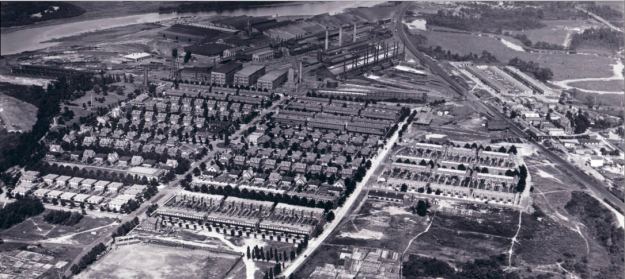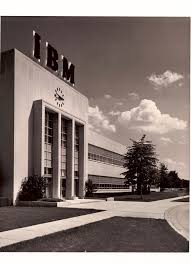The vast Roebling Mill, near Trenton, New Jersey, produced thousands of miles of steel cable for huge public-works projects like the George Washington and Golden Gate Bridges. At its peak, around World War II, it employed 5,000 people.
Most of those employees lived in a planned community, also called Roebling, in red-brick houses that had been constructed by the Roebling family expressly for their workers to live in.
The loyalty was palpable
When you were part of Roebling, you walked to work beside your neighbors along the leafy streets, through the gate house and down the hill to the factory site. Afterward you walked back together. Perhaps you stopped at the (subsidized) general store or at one of the taverns before going home to your family.
You were part of a community in every sense of the word.

The town of Roebling (foreground) and the steel mill in their heyday (Source: Hagley Digital Archives)
Today the mill buildings are gone, although the town with its brick houses and leafy streets remains. The stories of the mill and its people are told in the Roebling Museum, located in the old gate house.
The stories describe a remarkable esprit de corps, a strong bond between co-workers and neighbors who took great pride in their work, whose families gathered together on front porches, whose children competed together on the town’s sports teams.
When you were part of Roebling, the loyalty — yours to the company, and the company’s to you — was palpable.
Nothing lasts forever
When I visited the Roebling Museum earlier this month, those stories reminded me of my first few years at IBM. There I was steeped in a corporate culture that emphasized longevity and two-way loyalty. I never sang songs from the IBM hymn book, but some of my older colleagues had.
On the annual opinion survey, we were asked whether we agreed with a series of statements — one of which was I am confident that, as long as I do a good job, there will be a place for me at IBM. The hoped-for result was that all of us would mark Strongly Agree.
After a while they quietly took that statement out of the survey. After another while, for many of us, the statement proved to be false.
Nothing lasts forever. The Roebling Mill closed for good in 1974 after years of decline. IBM’s first layoffs (sorry, resource actions) took place in 1993. My pink slip came in 2002.
Trying to recapture a little of the old
I’m not suggesting that we can, or even should, return to those days of unswerving loyalty, of living in the safety of the corporate cocoon.
Still, the pendulum seems to have swung too far in the other direction.
Do you work in a place where you feel really connected with your co-workers, with a shared sense of mission and a shared pride in what you do?
Some of you do work in a place like that. But many of you don’t. Perhaps some of you have never experienced what it’s like.
Do you work in a place where you know that your employer has your back, that they care about you as a person and as a professional?
Again, while some of you do, I’ll wager that many more of you don’t.
Community and security
While it’s foolish and naive for workers to believe that the company will always take care of them, there’s value in identifying yourself with a company and in bonding with co-workers.
And while there are no guarantees, there’s also value in knowing that as long as you do a good job, the company will do its best to ensure that it has a place for you.
Community and security. I’ve worked in situations (like those early days at IBM) where I’ve felt like I had a lot of both. I’ve also worked in situations where I had essentially none.
I can tell you which one is better.
So, as managers and leaders, how can we give our workers a healthy, realistic sense of community and security?
Here are a few ideas. I hope you’ll add more ideas in the comments.
- Let your people know that you value them for the people they are, not just for the work they do. Recognize that some of them might be hurting, having been betrayed by a previous employer they thought they could trust.
- Invest in your people’s professional development. When you pay for someone to attend a training course, you’re saying that you can see them contributing in the long term, not just on the present project.
- Let your people have fun together. Even if their families don’t gather on front porches, you can help create an environment where they feel connected by things other than their day-to-day work.
As workers, how can we increase our sense of community and security when there seems to be too little of both? Perhaps that’s a topic for another blog post.
I’d love to hear your story of community and security: how you’ve coped with losing them, or maybe how you’ve lost them and managed to regain them.



